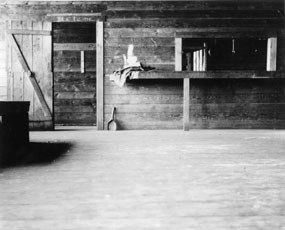
National Archives 
Courtesy Aleutian/Pribilof Island Association and the National Archives. "In 1942, my wife and our four children were whipped away from our home... all our possessions were left... for mother nature to destroy.... I tried to pretend it was really a dream and this could not happen to me and my dear family." -Bill Tcheripanoff, Sr., of Akutan
In response to Japanese aggression in the Aleutians, U.S. authorities evacuated 881 Unangax̂ from nine villages. They were herded from their homes onto cramped transport ships, most allowed only a single suitcase. Heartbroken, Atka villagers watched as U.S. servicemen set their homes and church afire so they would not fall into Japanese hands. The Unangax̂ were transported to Southeast Alaska and there crowded into "duration villages": abandoned canneries, a herring saltery, and gold mine camp-rotting facilities with no plumbing, electricity or toilets. The Unangax̂ lacked warm winter clothes, and camp food was poor, the water tainted. Accustomed to living in a world without trees, one open to the expansive sky, they suddenly found themselves crowded under the dense, shadowed canopy of the Southeast rainforest. For two years they would remain in these dark places, struggling to survive. Illness of one form or another struck all the evacuees, but medical care was often nonexistent, and the authorities were dismissive of the their complaints. Pneumonia and tuberculosis took the very young and the old. Thirty-two died at the Funter Bay camp, seventeen at Killisnoo, twenty at Ward Lake, five at Burnett Inlet. With the death of the elders so, too, passed their knowledge of traditional Unangax̂ ways. ![Elsie [Ermeloff] Yatchmenoff and her son, Feddie Yatchmeneff, both of Biorka, pose in a staged photograph from Ward Lake. Black and white image of a woman and man standing in room cluttered with open cardboard boxes and papers.](/aleu/learn/historyculture/images/Elsie_and_Feddie_Yatchemenef_-_Biorka.jpg?maxwidth=650&autorotate=false)
Courtesy Butler/Dale collection, Alaska State Library. "The overcrowded conditions were an abomination. There were 28 of us forced to live in one, designated 15'x20' house. There existed no church, no school, no medical facility, no store, no community facility, no skiffs or dories, no fishing gear and no hunting rifles. We had to abandon our heirlooms and pets even before the evacuation." -Philemon M. Tutiakoff, Unalaska Despite the horrors of the internment, the Unangax̂ refused to succumb to despair. Attempts to keep them sequestered from nearby villages and towns failed. Evacuees found jobs. They built new living quarters in their compounds, repaired the old structures, and brought in electricity and running water. The villagers of Unalaska erected a makeshift church and named it after their beloved Church of the Holy Ascension of Christ. The religious articles and holy cards brought from the villages took on immense importance, the Unangax̂ again turning to their faith for strength. Despite their poor treatment at the hands of the U.S. government, the Unangax̂ remained a fiercely patriotic people. Twenty-five Unangax̂ men joined the Armed Forces. Three took part in the U.S. invasion of Attu Island, and all were awarded the Bronze Star. At their camps, the Unangax̂ surreptitiously voted in Territorial elections. Through exposure to the outside world, they had come to understand the importance of their participation in the democracy by which they were governed, and they desired participation with the full rights of citizens. The next generation of Unangax̂ leaders spent their formative childhood years in these camps, and they would never forget the injustices they saw there. Learn more about the Unangax̂ evacuation and internment"Aleut Story" - a new documentary charts the journey of the Unangax̂ from the Aleutian and Pribilof Islands to Southeast Alaska and home again. This highly-acclaimed film weaves together personal testimony of evacuees with striking historical photographs and stunning footage. Visit the website at: www.aleutstory.tv Aleutian/Pribilof Islands Association - Cultural Heritage Services: The Cultural Heritage Department provides programs that encourage Unangax̂ culture and language to flourish. Located in Anchorage, Alaska, the Resource Library and Archive has an important collection of documents and photographs relating to the Evacuation and Internment. Visit the Aleutian/Pribilof Islands Association website. |
Last updated: March 29, 2018
